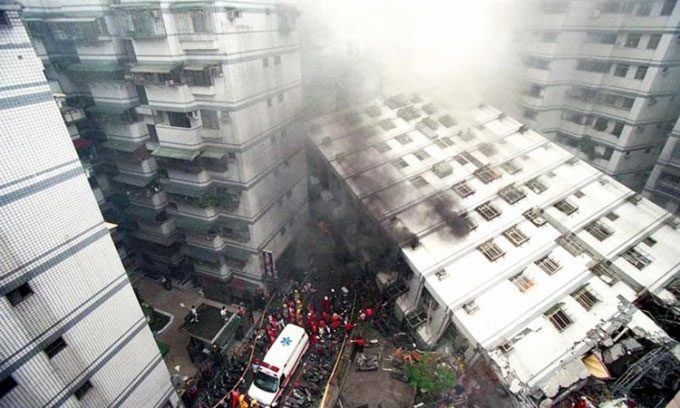The earthquake that claimed the lives of over 2,400 people in 1999 prompted Taiwan to change its building regulations and focus on enhancing earthquake resistance.
A 7.4 magnitude earthquake struck at 7:58 AM (6:58 AM Hanoi time), with its epicenter located off the eastern coast of Taiwan, near Hualien County, at a depth of 15.5 km. This is the strongest earthquake to hit the island in 25 years, following the 7.6 magnitude earthquake known as the 921 Earthquake, which resulted in 2,400 fatalities in 1999.
Although this earthquake registered a magnitude of 7.4, many high-rise buildings were merely tilted rather than collapsing entirely. According to Standard & Poor’s, Taiwan is one of the top 10 countries most susceptible to earthquakes worldwide. Most earthquakes since 1999 have been of smaller magnitude and caused fewer casualties. However, valuable lessons were learned from the disaster, and preparations were made to mitigate damage if a similarly large earthquake were to occur.

A building in Sinjhuang District collapsed during the 921 earthquake. (Photo: New Taipei City Public Works Department).
Establishing Earthquake Resistance Regulations for High-Rise Buildings
Following the significant casualties from the 921 earthquake, many called for changes to building regulations and construction methods. The government reclassified earthquake zones using updated data, adding more buildings in areas prone to strong earthquakes. Authorities also implemented new regulations for high-rise construction that include quality control, earthquake resistance assessments, and structural reinforcement measures.
For instance, the seismic design standards and regulations established in 1999 classified the Chelungpu Fault, which caused the 921 earthquake, as a Type 2 active fault. This classification did not require buildings constructed along the fault line to have adequate earthquake resistance.
Hwang Shyh-Jiann, the director-general of the National Center for Research and Engineering of Earthquake (NCREE) and a civil engineering professor at National Taiwan University, stated that “investigations revealed that the collapse of buildings during the 921 earthquake was mainly due to improper installation of reinforced concrete structures“. Poor reinforcement techniques included inadequate foundations to support rebar, spacing rebar too far apart, and using low-quality materials that led to low-strength concrete, among other issues.
Reinforcing Buildings Vulnerable to Earthquakes
After the 921 earthquake, in addition to the buildings that collapsed entirely or partially, a large number of structures were identified as vulnerable. Since it was not feasible to demolish and rebuild all these structures, the government initiated a reinforcement plan for these vulnerable buildings to enhance their earthquake resistance. According to Hwang, reinforced concrete buildings, including both public and private structures built prior to the 921 earthquake, accounted for 59% of the total floor area of all existing high-rises in Taiwan. These buildings are among the highest priority for assessment to determine if reinforcement is necessary.
Public buildings include schools, police stations, fire stations, and offices, with the reinforcement plan focusing primarily on schools. Since 2009, Taiwan’s Ministry of Education has promoted earthquake resistance assessments and reinforcement plans for schools. The importance of earthquake reinforcement became evident during the 2010 Kaohsiung earthquake. After the tremor, the columns of an unreinforced school were visibly damaged, exposing rebar, while the structure of another school just 1.2 kilometers away that had been reinforced showed no signs of damage.
Developing Technology
Although earthquake prediction technology still needs improvement, Taiwan has developed systems to provide warnings. By integrating monitoring devices with other technologies, when seismic waves are detected, the system can rapidly estimate the affected area and its destructive potential, subsequently issuing warnings to give people a few extra seconds to act before the shaking arrives.
The significant earthquake in 2016 that struck Meinong District in Kaohsiung prompted scholars and the Central Weather Bureau (CWB) to collaboratively develop an automated earthquake location system, capable of pinpointing the epicenter within seconds of the quake’s onset.
The system then estimates the seismic magnitude and intensity across Taiwan, relaying this information to the earthquake early warning system to issue alerts. In the event of a strong earthquake of magnitude 5 or greater, the system can send warnings to mobile phones in communities within 10 seconds.
According to Chen Kuo-chang, director of the CWB’s Seismology Center, with over 60% accuracy in the automatic positioning system, they hope to reduce notification time to 5 seconds in the future, making Taiwan the fastest earthquake warning system in the world, surpassing even Japan.
In 2022, Professor Yen Horng-yuan and colleagues from the Department of Earth Sciences at National Central University achieved a breakthrough in earthquake prediction by correlating data from electrical resistivity, geomagnetic, and ionospheric layers during earthquakes of magnitude 6 and above between 2013 and 2018. The analysis revealed corresponding anomalies that could serve as predictive factors for earthquakes.
Over 70% of earthquakes in Taiwan occur offshore near Yilan County and Hualien. Chen explains that this area is a subduction zone at the edge of the Eurasian and Philippine tectonic plates, making it geologically complex with numerous faults. The Manila Trench extends from near Fongshan, Pingtung to the Philippines, has the potential to generate earthquakes and tsunamis. Consequently, Taiwan has installed observation stations on the seabed connected by undersea cables from Toucheng in Yilan County to Fongshan, and southward from Fongshan along the eastern edge of the Manila Trench. This system reduces the time required to calculate parameters of offshore earthquakes from 35 seconds to 20 seconds, allowing the CWB to issue tsunami warnings. So far, only Taiwan, Japan, and the United States have established such an underwater monitoring network.
Located at the intersection of the Eurasian and Philippine plates, Taiwan experiences significant seismic activity, with 33 known faults and numerous hidden faults across the island. Approximately 8.6 million people live within 10 km of an active fault.
Taiwan experiences an average of 100 earthquakes daily, but most are minor tremors that most people do not feel. An earthquake must be at least 3.5 to 4.5 magnitude to be felt by those near its epicenter.


















































